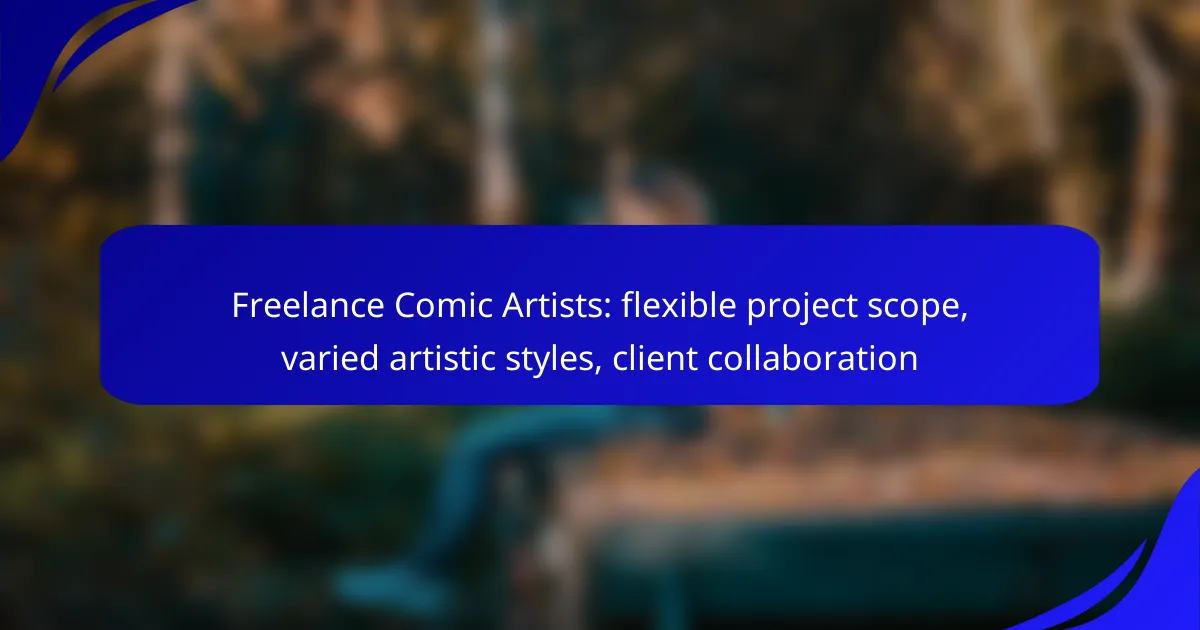Freelance comic artists offer a unique blend of flexibility and creativity, allowing them to adapt project scopes to meet client needs while showcasing a variety of artistic styles. By establishing clear boundaries and expectations from the start, they ensure a smooth collaboration that aligns artistic vision with client goals. This dynamic partnership often involves regular feedback and communication, enhancing the overall quality of the comic.

How do freelance comic artists manage project scope?
Freelance comic artists manage project scope by establishing clear boundaries and expectations with clients from the outset. This involves defining timelines, deliverables, and the degree of artistic input required, ensuring both parties are aligned throughout the creative process.
Flexible project timelines
Freelance comic artists often work with flexible project timelines that can adapt to client needs and personal schedules. This flexibility allows artists to take on multiple projects simultaneously or adjust their workload based on other commitments.
When setting timelines, artists should communicate clearly about their availability and any potential delays. For instance, a project that typically takes a few weeks might extend if additional revisions are requested, so it’s crucial to build in buffer time for unexpected changes.
Client-defined deliverables
Deliverables in freelance comic projects are typically defined by the client, which can include specific page counts, formats, or styles. Artists should clarify these requirements upfront to avoid misunderstandings later in the process.
It’s helpful to create a checklist of deliverables, such as character designs, storyboards, and final pages, to ensure all aspects are covered. Regular check-ins with the client can help confirm that the project is on track and meets their expectations.
Adjustable artistic input
Freelance comic artists often provide adjustable artistic input based on client feedback and preferences. This means that artists should be open to revisions and willing to adapt their style to align with the client’s vision.
To facilitate this, artists can present initial sketches or concepts for approval before proceeding with final artwork. This iterative approach allows for creative collaboration, ensuring that the final product resonates with the client’s objectives while maintaining the artist’s unique style.
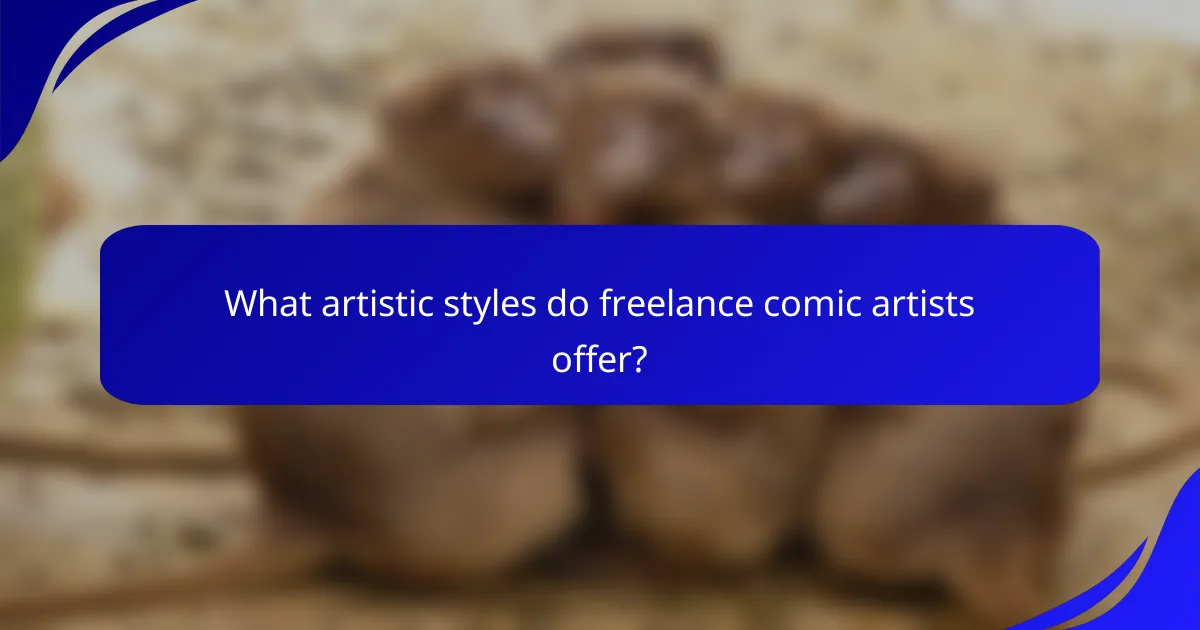
What artistic styles do freelance comic artists offer?
Freelance comic artists provide a diverse range of artistic styles, each suited to different narratives and audience preferences. These styles can significantly influence the tone and reception of a comic, making it essential for artists to showcase their unique approaches.
Traditional hand-drawn techniques
Traditional hand-drawn techniques involve using physical media such as pencils, inks, and watercolors. Artists often create detailed illustrations that convey a classic comic book feel, appealing to fans of vintage styles. This method allows for rich textures and organic lines, which can enhance the storytelling experience.
When working with traditional techniques, artists should consider the time and materials required. For example, creating a full comic page can take several hours to days, depending on the complexity and detail involved. It’s crucial to manage client expectations regarding timelines and revisions.
Digital illustration styles
Digital illustration styles utilize software tools to create artwork, offering flexibility and efficiency. Artists can experiment with various effects, colors, and layers without the constraints of physical materials. This method is popular for its ability to easily make adjustments and produce high-quality images quickly.
Common digital tools include Adobe Photoshop, Clip Studio Paint, and Procreate. Artists should familiarize themselves with these platforms to maximize their potential. Additionally, digital styles can range from clean, vector-based designs to painterly effects, allowing for a wide variety of artistic expressions.
Mixed media approaches
Mixed media approaches combine traditional and digital techniques, resulting in unique and innovative artwork. Artists might start with hand-drawn sketches, then enhance them digitally, or incorporate elements like collage or photography. This versatility can create visually striking comics that stand out in a crowded market.
When using mixed media, artists should be mindful of the cohesion of their styles. Balancing different techniques can be challenging, so it’s important to maintain a consistent aesthetic throughout the project. Clients often appreciate the originality that mixed media brings, but clear communication about the creative process is essential to ensure satisfaction.
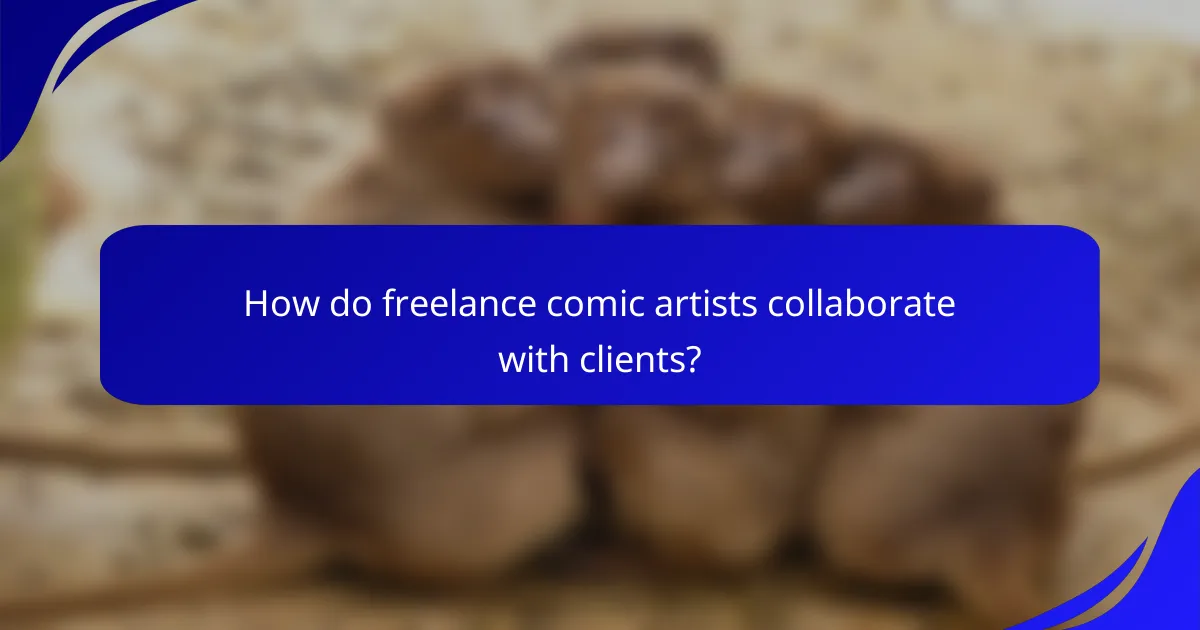
How do freelance comic artists collaborate with clients?
Freelance comic artists collaborate with clients through structured processes that ensure both parties are aligned on project goals and artistic vision. This collaboration often includes regular feedback, brainstorming sessions, and clear communication to enhance the final product.
Regular feedback sessions
Regular feedback sessions are essential for freelance comic artists to understand client expectations and make necessary adjustments. These sessions can be scheduled weekly or bi-weekly, allowing for timely input on sketches, storylines, and character designs.
Artists should encourage clients to provide specific feedback, focusing on elements like pacing, tone, and visual style. This helps to avoid major revisions later in the project and keeps the creative process aligned with the client’s vision.
Collaborative brainstorming tools
Using collaborative brainstorming tools can significantly enhance the creative process between freelance comic artists and their clients. Platforms like Miro or Trello allow both parties to share ideas, reference materials, and visual inspirations in real time.
These tools facilitate a more interactive experience, enabling artists to gather input directly from clients and incorporate their ideas into the artwork. This approach not only fosters creativity but also strengthens the working relationship.
Clear communication channels
Establishing clear communication channels is crucial for effective collaboration between freelance comic artists and clients. Utilizing platforms such as Slack or email ensures that all discussions, updates, and feedback are documented and easily accessible.
Artists should set expectations regarding response times and preferred communication methods to avoid misunderstandings. Regular check-ins can also help maintain momentum and ensure that both parties remain on the same page throughout the project.
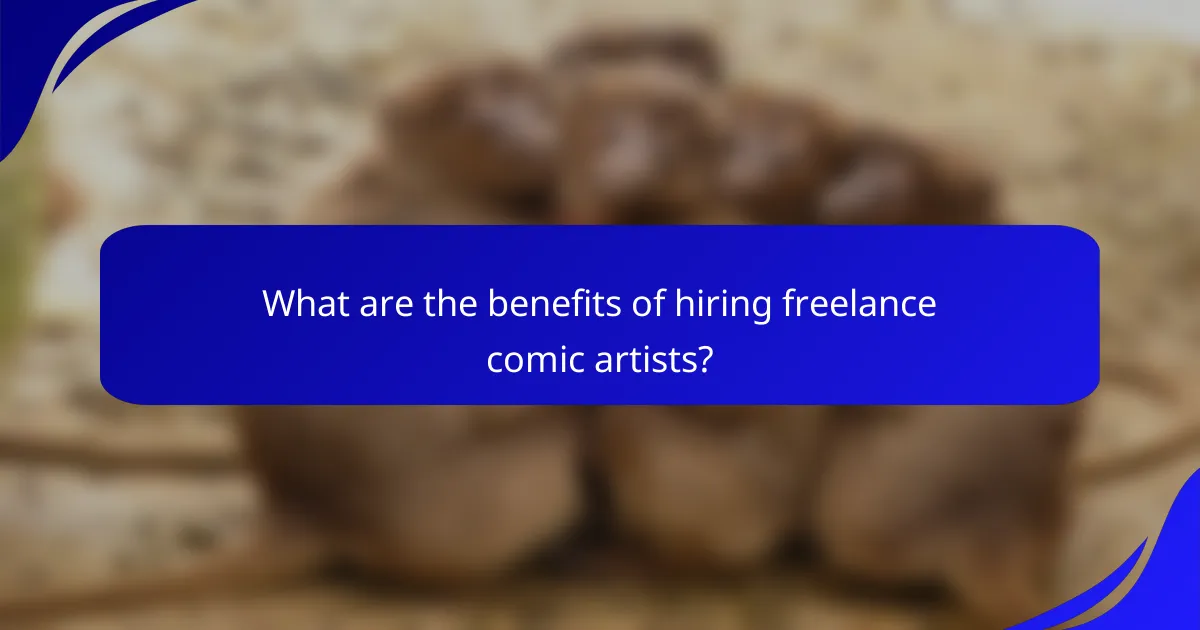
What are the benefits of hiring freelance comic artists?
Hiring freelance comic artists offers flexibility in project scope, a wide range of artistic styles, and the opportunity for close collaboration with clients. These benefits can significantly enhance the creative process and result in unique, tailored comic projects.
Cost-effective solutions
Freelance comic artists often provide cost-effective solutions compared to hiring full-time staff or agencies. Their pricing can vary widely, but many offer competitive rates that can fit within different budgets, from a few hundred to several thousand dollars depending on the project’s complexity and length.
When budgeting, consider the scope of work and the artist’s experience. Clear communication about your budget upfront can help in negotiating a fair price and avoiding unexpected costs.
Diverse creative perspectives
Freelance comic artists come from various backgrounds and artistic styles, bringing diverse creative perspectives to your project. This variety can lead to innovative storytelling and unique visual interpretations that resonate with different audiences.
Collaborating with artists who have distinct styles can enrich your comic’s narrative. For example, an artist skilled in surrealism may provide a fresh take on a fantasy story, while a minimalist artist could enhance a more introspective narrative.
Access to niche expertise
Many freelance comic artists specialize in niche genres or techniques, allowing you to tap into specific expertise that may not be available locally. Whether you need an artist proficient in manga, graphic novels, or webcomics, the freelance market offers a wide array of talent.
When searching for an artist, look for portfolios that showcase their specialization. This can ensure that the artist’s style aligns with your vision and that they have the necessary skills to bring your project to life effectively.

What are the challenges faced by freelance comic artists?
Freelance comic artists encounter various challenges that can impact their work and income. Key issues include inconsistent income streams, difficulties in managing client relationships, and the need to balance multiple projects simultaneously.
Inconsistent income streams
Freelance comic artists often face unpredictable income, as projects can vary significantly in duration and payment terms. Many artists may experience periods of feast and famine, where they have too much work at one time and none at another.
To mitigate this, artists should consider diversifying their client base and exploring multiple revenue streams, such as merchandise sales or crowdfunding. Setting aside savings during peak periods can also help manage leaner times.
Client management difficulties
Managing client expectations and communications can be a significant challenge for freelance comic artists. Misunderstandings regarding project scope, deadlines, and artistic direction can lead to dissatisfaction on both sides.
Establishing clear contracts and maintaining open lines of communication are essential. Regular updates and feedback sessions can help ensure that both the artist and client are aligned throughout the project.
Balancing multiple projects
Freelance comic artists often juggle several projects at once, which can lead to stress and burnout. Each project may have different deadlines and requirements, making it challenging to prioritize tasks effectively.
To manage multiple projects, artists should create a detailed schedule that outlines deadlines and milestones. Utilizing project management tools can also help keep track of progress and ensure that no project is neglected.
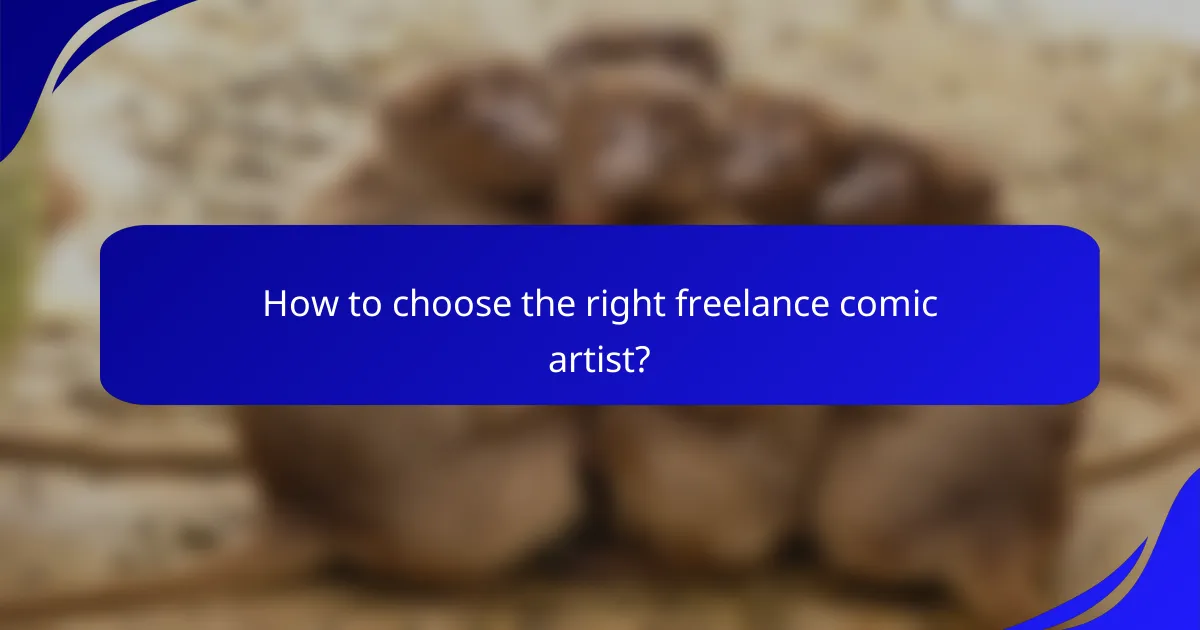
How to choose the right freelance comic artist?
Choosing the right freelance comic artist involves evaluating their portfolio, ensuring their artistic style aligns with your vision, and reviewing client feedback. These steps will help you find an artist who can effectively bring your project to life.
Reviewing portfolios
Start by examining the portfolios of potential comic artists. Look for a diverse range of completed works that showcase their ability to handle different themes, characters, and storylines. A strong portfolio should demonstrate not only technical skill but also creativity and storytelling ability.
When reviewing, pay attention to the consistency of their work. Artists who can maintain a coherent style across various projects are often more reliable for long-term collaborations. Consider creating a checklist of elements you want to see, such as character design, panel layout, and color usage.
Assessing style compatibility
Style compatibility is crucial for ensuring that the artist’s vision aligns with your project. Identify the specific artistic styles that resonate with your concept, whether it’s cartoonish, realistic, or abstract. Look for artists who have experience in the style you prefer, as this will enhance the overall quality of the comic.
To assess compatibility, you might ask for a small sample or commission a sketch to see how well the artist interprets your ideas. This can provide insight into their flexibility and willingness to adapt their style to meet your needs.
Evaluating client testimonials
Client testimonials offer valuable insights into an artist’s professionalism and reliability. Look for reviews that highlight the artist’s communication skills, adherence to deadlines, and overall satisfaction with the final product. Positive feedback can indicate a strong work ethic and a collaborative spirit.
Consider reaching out to previous clients for direct feedback if possible. Ask about their experiences regarding the artist’s responsiveness and ability to incorporate feedback. This information can help you gauge how well the artist might work with you on your project.
